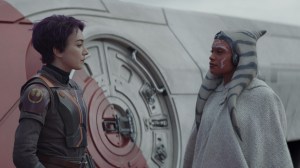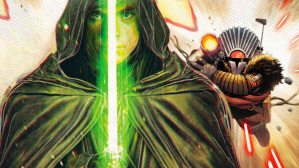The Star Wars saga has its fair share of iconic villains, from Darth Vader to Kylo Ren. Each is regularly seen in combat with rage behind every swing of their lightsabers. Since his initial debut in 1994, Grand Admiral Thrawn has displayed that immense strength can only get you so far, quickly becoming a fan-favorite character that deserved to be feared. Marvel’s new Thrawn series offers readers their first glimpse of how the character started down that path.
Videos by ComicBook.com
Deep in the heart of Wild Space, an Imperial squad attempts to locate an individual inhabiting the area, yet they suffer casualties while attempting to identify the threat. The squad eventually apprehends Mitth’raw’nuruodo, who allows himself to be called “Thrawn,” and is taken to Emperor Palpatine. A member of the Chiss species, thought to be nothing more than legend, Thrawn offers his tactical services to the Empire for the safety of his people. The xenophobic nature of the Imperial Academy makes Thrawn a target, with his only ally being his translator cadet Eli Vanto.

When Disney purchased Lucasfilm in 2012, everything outside of the six live-action films and the animated series Star Wars: The Clone Wars were eradicated from official canon, thus relegating Thrawn’s legacy — and his introductory novel, Heir to the Empire — to the “Legends” corner of Star Wars mythos. The power of the character couldn’t be denied, however, with producer Dave Filoni eventually reviving the character for the third season of Star Wars Rebels.
The character’s villainy also earned him his own novel, set within the official canon, written by Timothy Zahn, the original writer of the Thrawn Trilogy in which the character first appeared. This new title is merely the latest testament to the character’s complexities, as it’s an adaptation of Zahn’s recent Thrawn novel.
Oftentimes, the best tool for driving a nail into a piece of wood is a hammer, with Vader acting as Palpatine’s hammer or Kylo serving as Supreme Leader Snoke’s, easily accomplishing the task in front of them. The thrill of seeing Thrawn in action is that he is such a master tactician, his calculated moves prevent the nail from ever existing in the first place, making displays of brute force completely unnecessary.
Thrawn is easily one of the most intellectual villains in the Star Wars saga, which is what made Zahn’s novel so compelling. His words could paint vivid images of the villain to convey Thrawn’s menace with precision, as Thrawn isn’t a character known to mince words. The comic, which was adapted by Jody Hauser, covers the early chapters of the novel directly. Hauser touches upon all the major beats and accurately conveys Thrawn’s outlook and deceptive nature.
The biggest drawback of the book is that the graphic nature of the medium is nearly altogether unnecessary, as Thrawn’s motives have been conveyed wonderfully in both literature and animation. This isn’t to slight Luke Ross’ artwork on the book, and the pulpy tone fits the story as it depicts the early stages of an evil mastermind finding his way in the world. Two of the book’s most compelling sequences involve seemingly interesting bits of action, yet the most fascinating elements are the aftermath of these scenes.

One depicts Thrawn attending a card game involving fellow cadets despite facing potential consequences from his commanding officers. Thrawn’s calculated approach to the situation incorporates elements entirely outside of the game itself, allowing him to take the upper hand. Another scene features Thrawn and Vanto being attacked, with the aftermath of this scuffle being a stronger display of Thrawn’s abilities than the more exciting conflict itself.
For readers who are unaware of Thrawn as a character, Thrawn #1 makes for a solid introduction to the villain, and Rebels fans will likely appreciate seeing the origins of the Ghost crew’s biggest threat. Thrawn fanatics, however, might not see much need for the visual interpretation of an already captivating story.
Published by Marvel Comics
On February 14th
Written by Jody Hauser
Art by Luke Ross
Colors by Nolan Woodard





